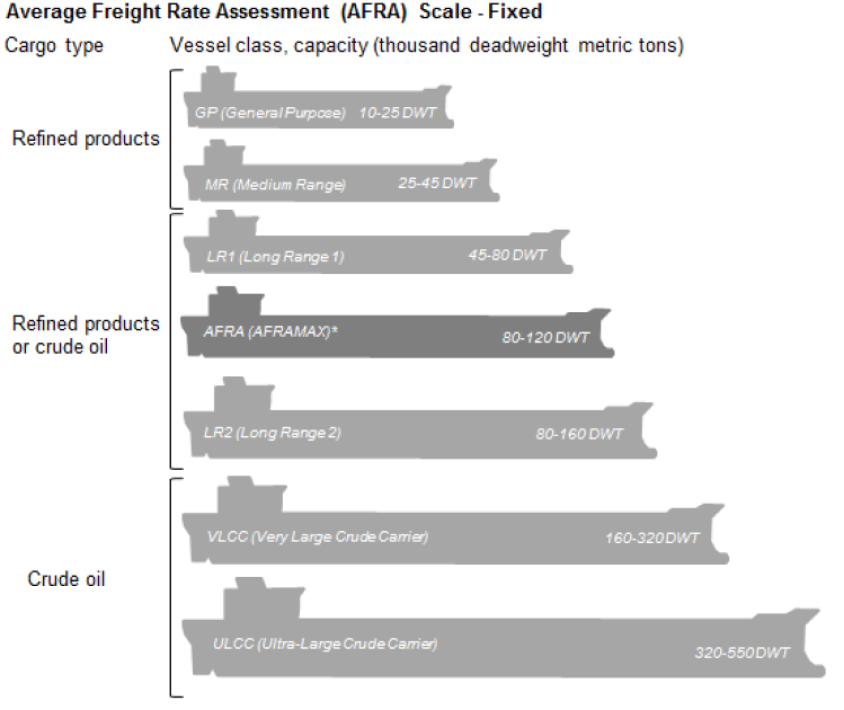
The global crude oil and refined product tanker fleet uses a classification system to standardize contract terms, establish shipping costs, and determine the ability of ships to travel into ports or through certain straits and channels. This system, known as the Average Freight Rate Assessment (AFRA) system, was established by Royal Dutch Shell six decades ago, and is overseen by the London Tanker Brokers' Panel, (LTBP), an independent group of shipping brokers. AFRA uses a scale that classifies tanker vessels according to dead-weight tons, a measure of a ship's capacity to carry cargo. The approximate capacity of a ship in barrels is determined by using an estimated 90% of a ship's dead-weight tonnage, and multiplying that by a barrel per metric ton conversion factor specific to each type of petroleum product and crude oil, as liquid fuel densities vary by type and grade.

The smaller vessels on the AFRA scale, the General Purpose (GP) and Medium
Range (MR) tankers, are commonly used to transport cargo's of refined
petroleum products over relatively shorter distances, such as from Europe
to the U.S. East Coast. Their smaller size allows them to access most
ports across the globe. A GP tanker can carry between 70,000 barrels and
190,000 barrels of motor gasoline (3.2-8 million gallons) and an MR tanker
can carry between 190,000 barrels and 345,000 barrels (8-14.5 million
gallons). Long Range (LR) class ships are the most common in the global
tanker fleet, as they are used to carry both refined products and crude
oil. These ships can access most large ports that ship crude oil and
petroleum products. An LR1 tanker can carry between 345,000 barrels and
615,000 barrels of gasoline (14.5-25.8 million gallons) or between 310,000
barrels and 550,000 barrels of light sweet crude oil. A classification
used to describe a large portion of the global tanker fleet is AFRAMAX.
AFRAMAX vessels refer to ships between 80,000 and 120,000 dead-weight
tons. This ship size is popular with oil companies for logistical
purposes, and, therefore, many ships have been built within these
specifications. Because the AFRAMAX range exists somewhere between the LR1
and LR2 AFRA scales, the LTBP does not publish a freight assessment
specifically for AFRAMAX vessels. Over the history of AFRA, vessels grew
in size and newer classifications were added. The Very Large Crude Carrier
(VLCC) and Ultra-Large Crude Carrier (ULCC) were added as the global oil
trade expanded and larger vessels provided better economics for crude
shipments. VLCC's are responsible for most crude oil shipments around the
globe, including in the North Sea, home of the crude oil price benchmark
Brent. A VLCC can carry between 1.9 million and 2.2 million barrels of a
WTI type crude oil.
The can accommodate VLCC vessels, The Port of Corpus Christi is a
major crude oil refinery hub comprising six refineries and the top
petroleum commodities include crude oil, diesel, gasoline, fuel oil,
naphtha, jet fuel, etc. The Port of Corpus Christi owns multiple public
oil docks in the Inner Harbor capable of handling many liquid bulk cargo
commodities, including petroleum and petrochemical products. The berths
range from 246 feet (75 meters) to 1,000 feet (304.8 meters), with berth
depths up to 47 feet. The largest public oil docks in the Inner Harbor
are designed to handle Suez-max (LR2 and VLCC) size (160,000 DWT) crude
oil tankers capable of loading 1,200,000 barrels of crude oil. Several
industry customers of the Port of Corpus Christi operate multiple
private terminals and oil docks including crude oil export facilities at
IngleSide with berths designed to handle VLCC (Very Large Crude Carrier)
size (300,000 DWT) crude oil tankers capable of loading 2,000,000
barrels of crude oil.
There are a small number of ULCC vessels currently in use, as their
size requires special facilities limiting the number of places where
these vessels can load and offload. These massive vessels can carry
around 2 million barrels to 3.7 million barrels of crude oil. The only
U.S. port that can handle such large vessels while fully loaded is the Louisiana
Offshore Oil Port (LOOP).